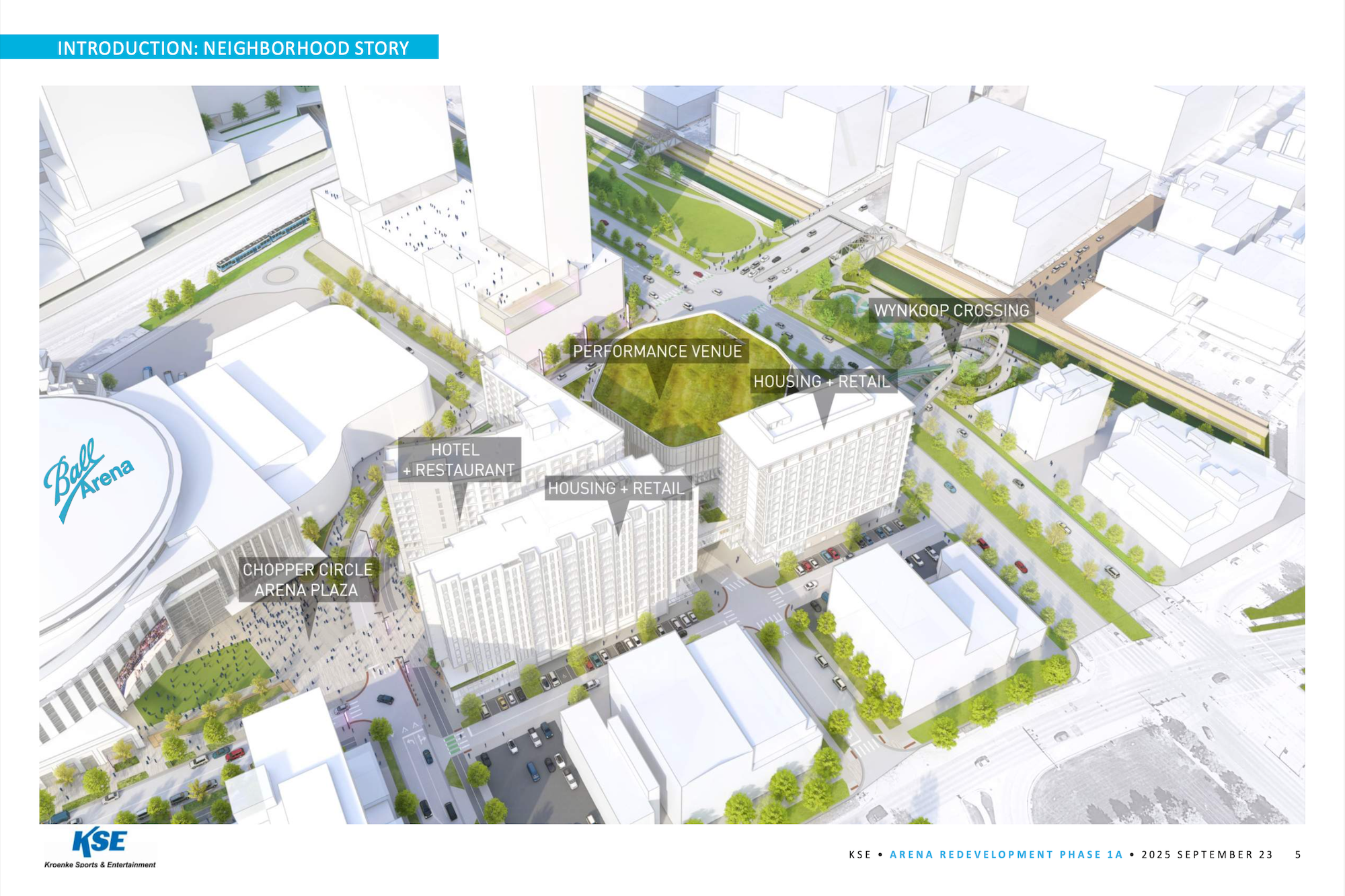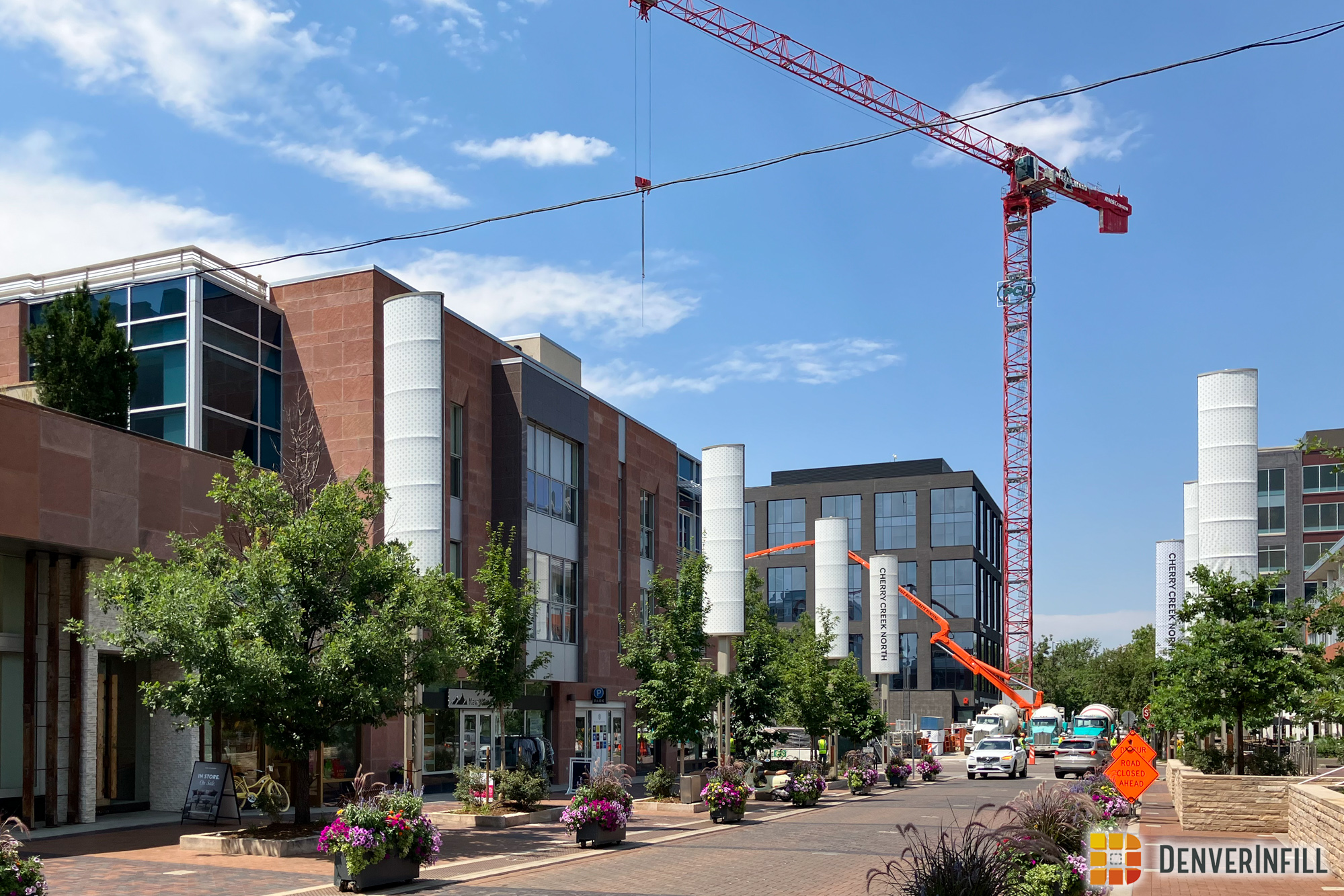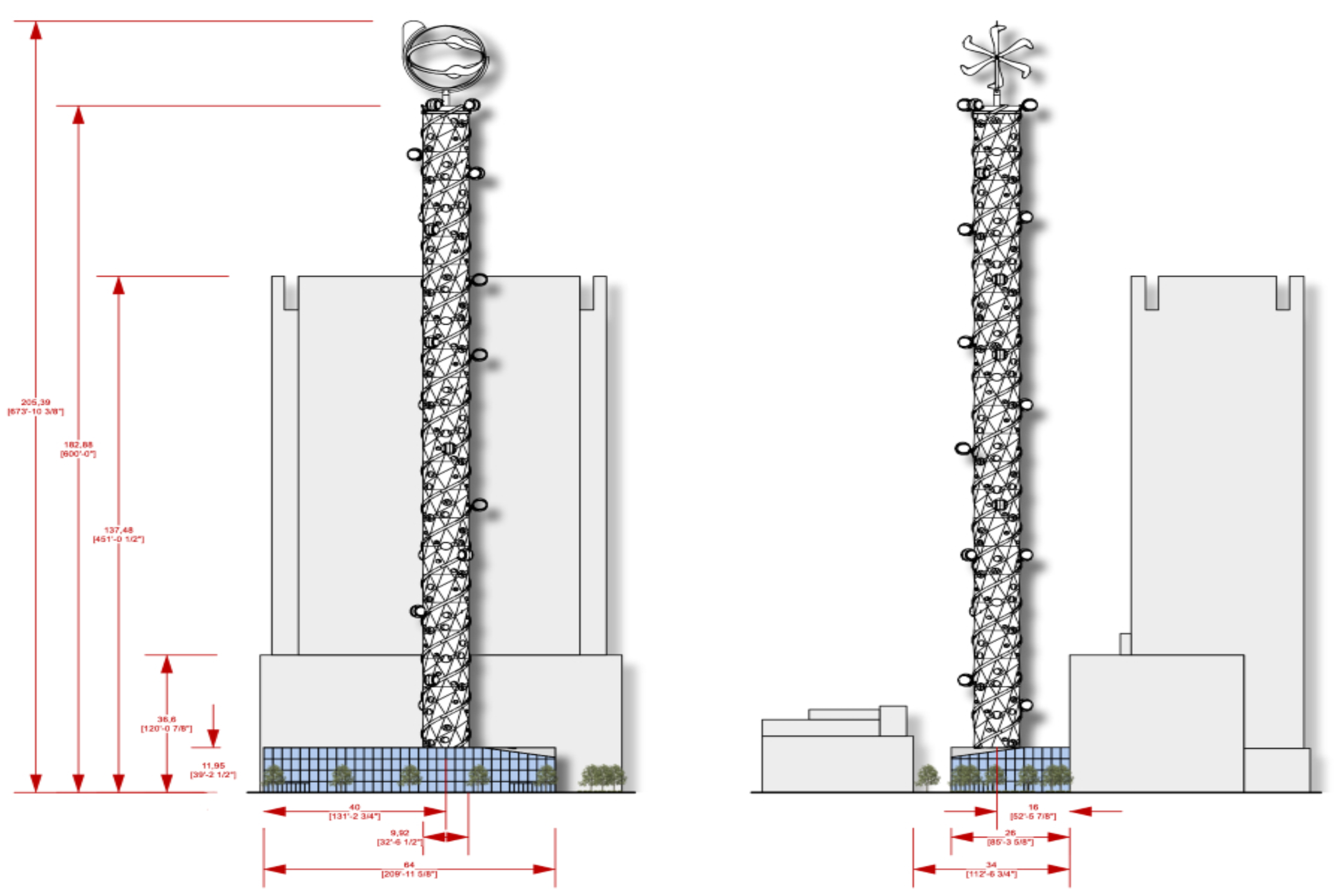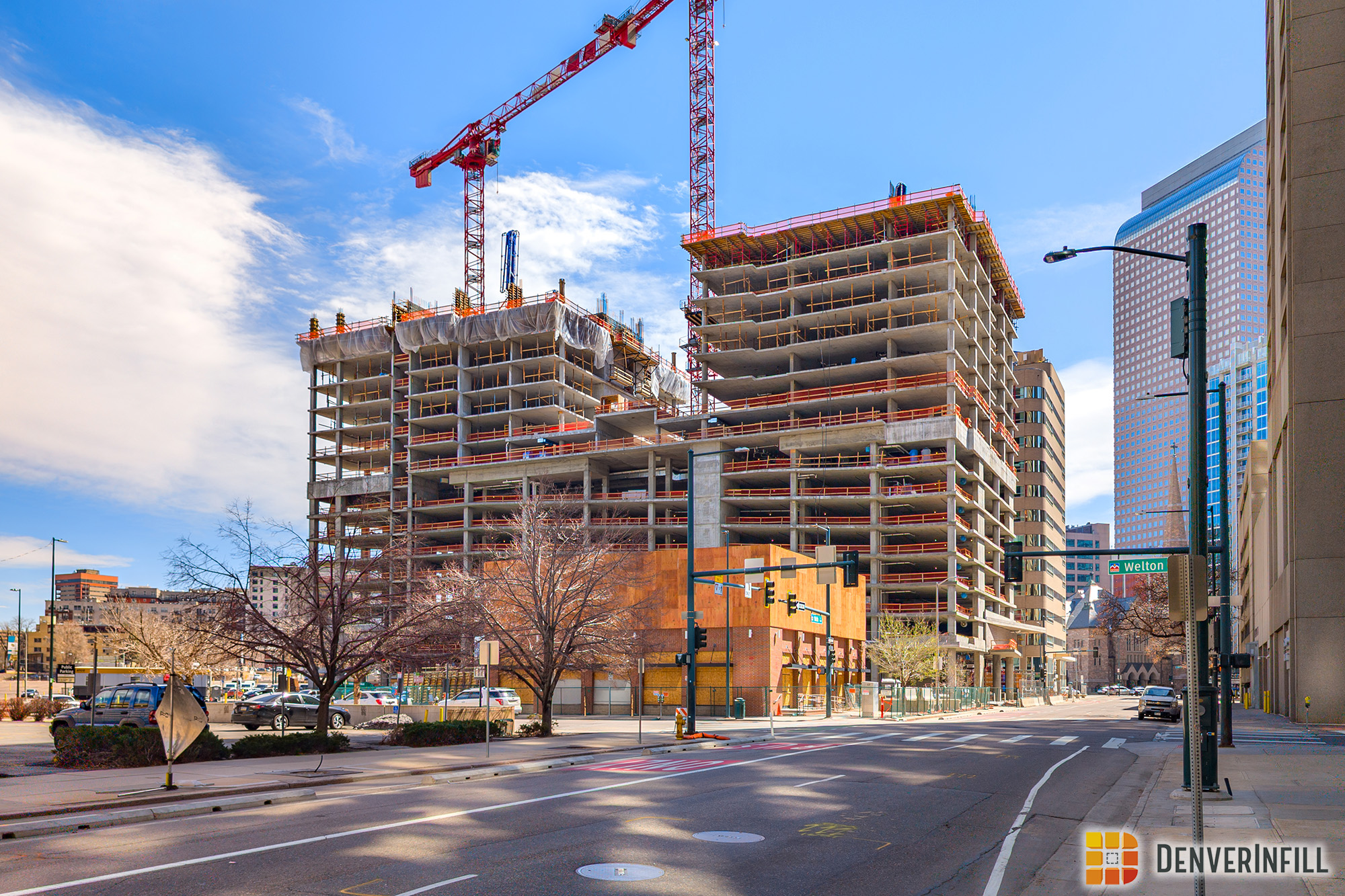The 14-story Delaware Lofts project, now known as the Civic Lofts, is starting to look more complete. Back in November, we mentioned that the project had topped out with most of the building covered with scaffolding. Now, most of the facade is complete with just a few finishing touches to go.
Let’s start out with a couple of street-level views of the project from along both Delaware Street and West 13th Avenue.
By now, you have probably identified what element of the project looks a bit out of place. The exposed parking podium is less than appealing and, even though it looks like that side of the building is complete, we truly hope there are plans to cover or screen it. The rendering, courtesy of the project’s website, does not give us much hope.
Traveling around the project, here are four more photos of the Civic Lofts from the corners and alley side.
According to the website, leasing is expected to begin in late August. We will swing by then for a final update.



















I really wish in these lower zoned districts they would make height exemptions for crowns. At this point they should add an incentive for them, all these big projects in GT are flaaaaaat on top.
+1
I would be embarrassed having my name attached to this monstrosity. All involved- architect, developer, investors, etc should hang their heads in shame. I can honestly say I would rather have the parking lot back then having to look at this mess.
Denver’s going to be an ugly city in a few decades. The mountain backdrop can’t save the city from uninspired architecture.
Yep. This project looks as bad as some of the apt. buildings around from the late 60’s/70s. Yeesh.
Nice infill, but per usual, that parking podium is nauseating.
Are there proven ways to make parking podiums… better? Either visually or functionally. Even slapping a couple big flat surfaces for mural-painting (as alluded to in this blogpost) would be better than this.
Thanks for the pictures and the article!
Of course there is. Any number of interesting facade treatments could be considered here. All of them being more attractive than the naked parking podium and all of them more expensive as well. So if nothing is required by zoning or design review, why would an out-of-town developer who cares nothing for this city be compelled to add facade treatment to their garage? They wouldn’t, and that’s why you get this bs.
Seems to me the best way to improve a parking podium would be to get rid of it entirely.
+1
How about a citizen-led initiative for design review board covering all of Denver? Developers are making MILLIONS when they build and sell these apartments. They are profiting off the dynamic and enjoyable city Denver became through homegrown efforts. They show up from Austin, or San Francisco, or Chicago, and build absolute junk that contribute nothing – from an architectural or livability perspective – to our city. They leave with their millions, and we are left with a city that has increasingly has no character, pedestrian scale, or appeal to the folks who seek out those attributes. E is correct. The mountains can only carry Denver’s water for so long. Requiring developers to build quality stuff through a design review process may cost them a very small percentage of their millions in profits. I would have no sympathy for them.
I agreed. Tired of developers taking dumps on the city with stuff like this. Make design review mandatory.
Incentive for good design. Penalty for bad. Extra penalty for podium parking downtown and in the core. Who is the architect? Developer?
tall building. i hope the developer puts up some cladding around the exposed concrete that makes up the parking garage. it’s honestly really quite ugly and i’ve seen a variety of options from wood slats to metal to even led but as is it really is quite disturbing the developer or the city would approve that
That parking garage is truly a slap in the face. It’s enough to make me reconsider my opinion on design review.
This went from promising to disaster real quick! I’m about to leave this city based on garbage architecture alone.
If there’s anything I’ve learned from reading opinions about local development, it’s that a citizen design review board would be a comically bad idea. “Oh, no. You can’t build that. The Golden Triangle has TOO many flat-topped buildings. You’re going to need to add a crown to this residential building before we can allow you to proceed!”
What needs to happen is for city council to realize car ownership will soon be a thing of the past and all these parking garages will be about as useful as shag carpet in a handful of years. The parking regulations of the books are entirely too generous as they stand today. Minimum requirements need to be reduced drastically (or abolished) and people need to stop revolving their lives around the antiquated automobile in urban areas.
Just to clarify, jmpmk2, I’m not for a “citizen design review board.” Rather, an initiative put on the ballot by citizens to create a citywide design review board made of TBD members.
Golden Triangle, in which this site falls, does have “Design Standards,” so I imagine there was some sort of review that happened here at some point to ensure compliance? The guidelines are pretty silent on parking garages. Shame.
I think you hit the nail on the head. There ARE design review boards, there ARE standards—certain neighborhoods just haven’t evolved out of the single-occupant car and exposed parking garage model of the ’70s and ’80s. Citizens should be much more vocal about the criteria these entities are reviewing. Any standards giving preferential treatment to cars in 2019 simply isn’t serving the community.
What I don’t understand is that how could the developer make a change from the plans that are on file with the city. The plans on file can be viewed by going to the ‘Site Development Plans’ map here: https://www.denvergov.org/Maps/map/sitedevelopmentplans
The original plans showed all of the parking podium covered but updated plans still show a portion of each level of the parking podium covered (45%) with a large screen covering the center portion facing 13th Ave.
Its not very nice but ya’ll are really dramatic about it haha. It’s still better than a vacant surface parking lot. And like it or not, cars are thing that will not be going anywhere anytime soon.
I don’t think we’re being dramatic at all. Here’s a picture of Incheon, South Korea, a city with very uninspired architecture (apart from Songdo). Beauty, natural and man-made, breeds happiness. Ugliness, natural and man-made, breeds sadness. While I adjusted to the rows of concrete masses, I always felt a bit depressed by the landscape.
There are things developers/architects can do to enhance aesthetics without destroying the budget. I’m building a house and have worked with the architects to find inexpensive ways to dress up the facade. Does it cost a bit more? Yes. But, I see it as a civic duty not to build garbage. The difference with commercial construction is that renters/condo buyers care less about the appearance of the building. Also, developers are more profit oriented (many are public companies, have larger payroll, have boards, etc.). Thus, commercial developers tend to design to the lowest standards that can pass the permitting process. I’m a libertarian at heart; however, I believe there’s a place for government (roads, parks, etc.). Put design standards on the list. We must beef up Denver’s design standards and force these developers to put up more than boxes with parking podiums. My fear is that Denver will become an Incheon if we allow this type of construction to continue.
I agree that it could be better and should be better, but do other American cities not have this same problem? Maybe on a smaller scale but these national developers are probably doing the same thing everywhere.
I also think that something like an exposed parking podium will be noticed less by people who aren’t development nerds like the people on this blog. Many people will just see a new building without seeing the missed opportunity.
One more thing, I work frequently with architects and I do believe that they take pride in their work and care about the appearance of the final project. But things get cut from the design as the project progresses. Denver is a very expensive construction market now, something that out-of-town developers underestimate before they come here. I’ve worked on several projects in which the developer/owner has gotten the first bids from construction contractors and panicked about the high cost, immediately looking to cut costs and remove design components. That is how things happen like on this project how the initial design included something covering the parking podium but is no longer in the design.
The main culprits for design catastrophes seem to be developers from Texas. In lieu of a design review board, why don’t we just ban Texans from developing multifamily? All kidding aside, hopefully they cover the parking podium OR hopefully responsible people choose NOT TO LEASE THERE if it doesn’t get covered. I welcome the units nonetheless and the very minimal retail space. It’s still better than the shady bond bail houses that used to be there!
I like it. I think it has a minimalist, retro feel to it. Plus the parking podium is going to be partially covered. I was really impressed with their website too. #civivdenver
Partially covered is not a good solution, sorry. The garage is very imposing and it’s a shame that it will not be incorporated into the building’s facade.
Parq on Speer has a covered podium and it looks nice. Uncovered podiums are a blight on the urban landscape.
Ew
I’ve never seen a group of blander buildings.
Developers are notoriously cheap. This is no exception. That being said, Denver has a housing shortage, and you should all be ashamed of yourselves as chooser-beggers. I’m more offended by the amount of stucco on this project than the parking deck, honestly, but at least the deck can be covered sometime in the future when the new owner of the building realizes the blight of it.
beggar typo my bad.
I agree that the parking podium is an eyesore, and it would be much nicer if it were covered up; however, covering up a parking garage is very costly. You’re not just paying for the facade treatment, but also a ventilation if the garage is not open enough to the outside air. We’re talking about potentially several million dollars without any tangible return for the developer. If we want developers to give the public nicer looking buildings, then Denver needs to provide incentives for them to spend the extra money.
Maybe they could cover up the parking podium with advertisements from all the Bail Bonds businesses in the area. Stay classy Denver. ?
Golden Triangle has not been a great feature of Denver’s design for many decades. All of the old buildings were demolished, and generally replaced with low grade buildings and parking lots, so there is no specific loss here to Denver’s historic structure inventory. The area has been struggling to keep up with the jail and the justice center; adding hotels and residential building to the area diversifies away from the government uses that pay no property tax revenue.
Denver is suffering from the hangover of the Poundstone Amendment, when revenue was severely impacted by growth restrictions, and the recovery from that impact has been over compensation, with a an aggressive drive to grow the city at all costs. The design and development of the latest growth spurt has not been spectacular in a a number of cases, but the design was secondary to the revenue generation.
Denver designers and developers could not do the job alone, and Denver architects get a fair share of their work outside of Denver, and around the world in some cases.
What is missing is a better explanation to the public of the Golden Triangle development plan, fully built out.
I agree that this structure could have done a far better job with the podium, and – why couldn’t the garage portion be fully enclosed and heated?
Poor design from a functional standpoint in Denver’s winter months.
help may be on the way … http://www.denvergov.org/goldentriangle
“The project will include updated design standards and guidelines to address more qualitative design aspects recommended by the plan, along with design review by the recently enabled Downtown Design Advisory Board.”
I know there is a lot of bad feelings about this uncovered podium. However, in some ways the podium does kind of mirror the blond-brick brutalist-modernism of the Denver Police Department Headquarters buildings that are just across the street.I don’t see that this new building is really any uglier than that older building. That’s not saying we can’t do better in the future, but it does acknowledge that the problem with ugly architecture is not new in this city.
Finally, someone noticed the symmetry with the DP headquarters. I think it’s kinda cool and really softens the stark contrast the headquarters would have had when this area further develops with more modern structures.
A neighborhood full of exposed parking podiums to obviously not the direction anyone wants in Denver but this comment section has become comical in its display of lacking objectivity and the death grip people have on their dogmatic views. We could all deal with being a bit more open and maybe try to display some positivity. The world is not going to become a cesspool or flaming orb if everything doesn’t fit your world view or design aesthetics.
AC, we can excuse the 1970s era DPD buildings as that was the type of architecture we had at the time, but to build this monstrosity in 2019 is inexcusable.
Corey – Why does it matter if other American cities have this problem? They look like crap, so we can look like crap? Portland has design standards. Their rents are lower than Denver’s, and their job market is as hot, so how can they find the will to enact stricter standards and continue to see strong growth and development, while Denver submits to sub-par architecture?
Of course architects take pride in their work. They WANT to innovate and contribute to a better Denver. I don’t think anyone here has said it’s the architect’s fault. It’s the developers who cut, cut, cut so they can maintain their 6.5% return on cost, so the profit when they sell at a 4.5% cap rate remains utterly exorbitant.
Again, I got no pity for developers who want to come here and make slightly less than the gazillion dollars they normally make when developing multifamily in Denver because they have to adhere to some more strict design standards. I don’t give a gosh darn if Texas Developer X comes into town and is shell-shocked by construction costs. They can play our game, which could mean doing something more than the lifeless stucco commodity product their respective hometowns let them vomit onto the Texas prairie. They may scoff at the idea, and back away at first. Someone else who’s willing to play the game will fill the void, because Denver continues to grow and attract people who need apartments to rent, and developers don’t make money unless they’re building apartments. They need to build to feed their families. Those folks who fill the void will accept slightly lower returns, and eventually Texas Developer X will be back to play the game because Denver is too good an opportunity to pass up.
Costs do increase with additional design requirements. Let’s say a $40 million apartment building costs an additional $1-1.5 million to build – who knows. Who makes up the difference? Some will say renters pay more and the city becomes more expensive. Perhaps, if it so constricts supply that rents increase due to supply/demand imbalance. Again, I want to see how much of a supply hit occurs, given new developers with lower return requirements could still fill the void. Boulder’s very strict standards and land use restrictions certainly have not deterred developers from salivating over any opportunity to build there. And, though this enters a level of economics above my pay grade, I have little reason to believe rents can actually increase any more than the market has already allowed them to. What I mean is, developers already charge exactly what the market will bear. They aren’t leaving any scraps on the table to be kind-hearted. They have rent programs like Yardi that calculate – every single day – the maximum rent they should charge on a given unit. They are at the level already where any additional rents cause people to seek alternatives – older product, suburban, or leaving Denver entirely. Not one penny less than that overall strike price. Their algorithms know Noah makes $80k per year and spends $10k of that on avocado toast so he has $70k less his student loan payments and taxes to spend on rent. So, given we increase construction costs for them, and assuming the median income/tolerance to pay a certain level of rent remains the same, the rents really cannot go up because we are already at the highest level possible. So, Texas Developer X absorbs the cost of those requirements and continues to rent at the same ungodly rates they do today because the market will not bear any more. Absorbing those costs drives down the returns/profits, which goes back to my hypothesis that Texas Developer X leaves in a huff worthy of a Real Housewife, Local Denver Developer X who accepts the lower returns fills the void, Texas Developer X eventually comes back because their babies need their food.
I made a lot of assumptions there, but I’m going to assume I’m right because this is the internet and I can do that.
Noah – your analysis seems spot on but only if the void created by lower returns is filled by a developer willing to take on more risk for a lower return than the rest of the market. That may work 5 or 6 or even 9 times out of 10, who knows, but the point is that less units are produced due to design requirements, which in turn makes housing more expensive and continues the downward spiral of the supply/demand imbalance. If you can build any structure in Chicago, or DC, or Seattle for less money than you can build the same product in Denver, why would you develop in Denver when the rents are lower here than those markets. I hypothesize that the really high quality developers who build striking vertical buildings on the coasts aren’t in Denver precisely because of those lower economics. Soooo, we end up getting the second or third tier developers from the heartland who make a lot of money building cheap stuff, then bring that mentality to Denver, and we get more cheap stuff. Some of the highest quality structures built in this and other real estate cycles have been completed by out of state developers. This works well, you get a few signature structures and the rest of the building stock is filler, completed by local developers and architecture firms. By the way, I think architects bear an enormous responsibility for the poor designs we are seeing in modern architecture today. While developers do strip down components of buildings to cheapen them up, the form and scale is largely determined by 1) zoning and 2) the architect. Architects need to do better and stop obsessing with this boxy, flat form stuff and developers need to take a longer view than 3-5 years, that’s the bottom line.